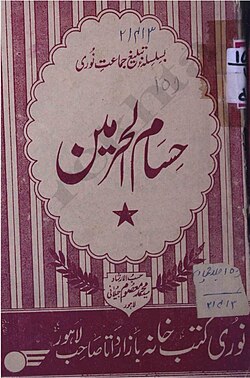Religion:Husamul Haramain
Husamul Haramain (Ḥusām al-Haramayn) or Husam al Harmain Ala Munhir kufr wal mayn (The Sword of the Two Holy Mosques to the throats of non-believers) 1906, is a treatise written by Ahmad Raza Khan (1856- 1921) which declared the founders of the Deobandi, Ahle Hadith and Ahmadiyya movements as heretics.[1][2][3][4]
The treatise is published in Arabic, Urdu, English, Turkish and in Hindi language and its pledge is mandatory in Al Jamiatul Ashrafia.[5]
History
In 1905, Khan performed pilgrimage to Holy Sites in the Hejaz. During this period, he prepared a draft document entitled "al-Motamad al-Mustanad" (The Reliable Proofs) in which he argued against opinions of founders of Deobandi, Ahl-e Hadith and Ahmadiyya movements for presentation to his contemporaries in Mecca and Medina. Khan collected scholarly opinions of thirty-three fellow scholars' verdicts. All of them concurred with his assertion that the founders of Deobandi, Ahmadiyya and Ahl-e Hadith movements were apostate and blasphemers. They also exhorted the government of British India to execute the founders of those movements for heresy.[6][7][8]
The fatwa deals separately regarding each of the following:
Deobandi
The major Deobandi scholars Muhammad Qasim Nanautawi, Rashid Ahmad Gangohi and Ashraf Ali Thanwi were stated as infidels allegedly for producing blasphemous texts against Allah, Muhammad and the Awliya. Khalil Ahmed Saharanpuri then compiled a set of questions and answers and took signatures from various scholars at Darul Uloom Deoband entitled Al-Muhannad ala al-Mufannad and submitted it to scholars of Makkah and Madinah. The book consisted of agreed upon creeds of Deobandi scholars which in turn confirmed the beliefs of Barelvi Muslims.[9]
Ahmadiyya
Mirza Ghulam Qadiyani, the founder of Ahmadi movement stated as being outside the fold of Islam due to supposed violation of the belief regarding the Finality of Prophethood of Muhammad.
See also
- Fatawa-e-Alamgiri
- Fatawa-e-Razvia
References
- ↑ Madsen, Stig Toft; Nielsen, Kenneth Bo; Skoda, Uwe (2011). Trysts with Democracy. Anthem Press. ISBN 9780857287731. https://books.google.com/books?id=6w7JVOlDIokC&q=hussam+ul+haramain+published+by&pg=PA282.
- ↑ Gaier, Malte (2012). Muslimischer Nationalismus, Fundamentalismus und Widerstand in Pakistan. LIT Verlag Münster. ISBN 9783643110114. https://books.google.com/books?id=5vTvMVyhmigC&q=Hussam+al+Haramain&pg=PA62.
- ↑ Usha Sanyal Devotional Islam and Politics in British India: Ahmad Raza Khan Barelwi and His Movement, 1870–1920.
- ↑ https://hudson.org/content/researchattachments/attachment/1283/kahn_vol12.pdf .[bare URL PDF]
- ↑ Osella, Filippo; Osella, Caroline (16 May 2013). Islamic Reform in South Asia. Cambridge University Press. ISBN 9781107031753. https://books.google.com/books?id=ipU-cTz5_JYC&q=Hussam+al+Haramain&pg=PA124.
- ↑ Gregory C. Doxlowski. Devotional Islam and Politics in British India: Ahmad Riza Khan Barelwi and His Movement, 1870-1920. The Journal of the American Oriental Society, October –December, 1999.
- ↑ Husamul Haramain, Imam Ahmed Raza Khan, published by Raza Academy, 2005, p. 32-50.
- ↑ Masud, Muhammad Khalid; Messick, Brinkley Morris; Powers, David Stephan (2005). Islamic Legal Interpretation. Oxford University Press. ISBN 978-0-19-597911-4. https://books.google.com/books?id=_QDYAAAAMAAJ&q=Hussam+al+Haramain.
- ↑ "al-Muhannad ala al-Mufannad" (in en-gb). https://www.thesunniway.com/articles/item/14-al-muhannad-ala-al-mufannad.
Further reading
- The Enemy within: Madrasa and Muslim Identity in North India by Arshad Alam, Modern Asian Studies Vol. 42, No. 2/3, Islam in South Asia (Mar. - May, 2008), pp. 605–627
- Holy Quran's Judgement, Part 2 By M.S.M Abdullah
- Who is a Muslim? Identities of exclusion—north Indian Muslims, c. 1860–1900, S.A. Zaidi,Independent Scholar, Karachi
- Madrasas in South Asia: Teaching Terror? edited by Jamal Malik, Professor and Chair of Religious Studies - Islamic Studies Jamal Malik
External links
 |


